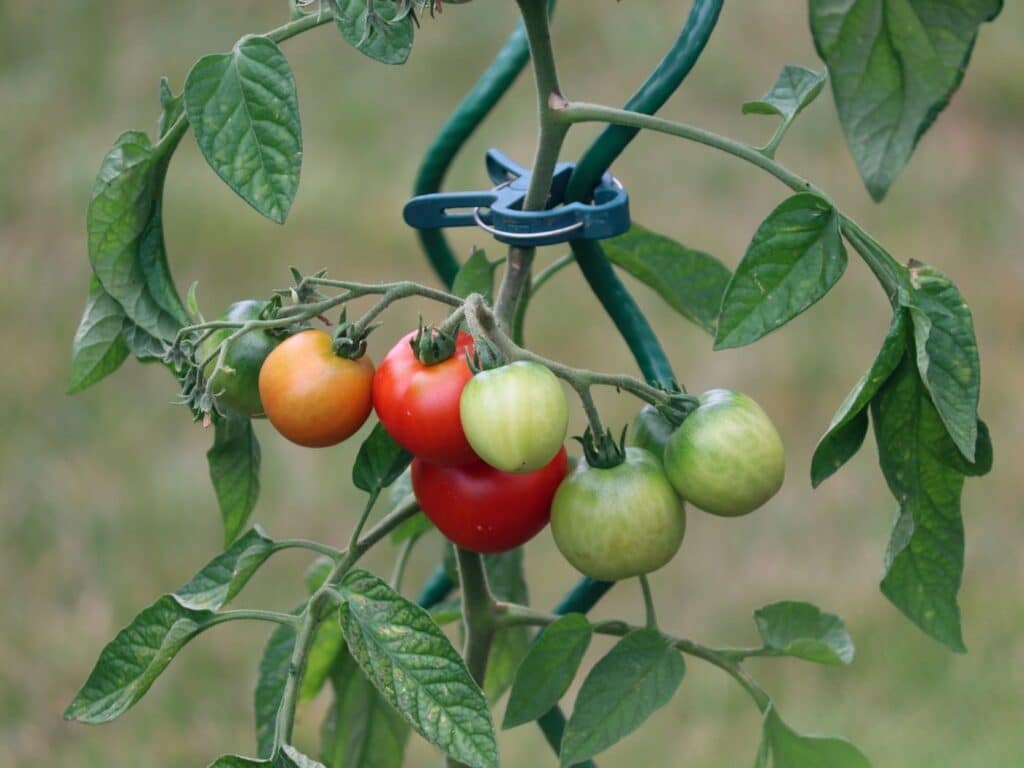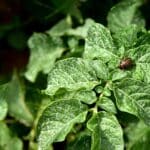Companion planting in a vegetable garden offers many benefits, but only if you pair suitable vegetables and herbs with the right partners.
Certain plants can impact the taste and smell of vegetables in your garden bed or might even affect the growth and development of these food sources. Some plants are also great for keeping pests from devouring your tomatoes.
In this guide, we will look at some of the best tomato companion plants to consider if you want to produce the biggest and sweetest tomatoes.

What to Plant with Tomatoes
Many plant varieties can be successfully grown in the same garden bed as tomato plants (Solanum Lycopersicum). You can also select neighboring plants for specific purposes. Some companion plants are great for controlling pests, and some are ideal for boosting the growth and development of tomato plants.
Some companion plants can attract beneficial insects, and some can help reduce diseases in your garden bed. Here is a quick look at the top companion plants for tomatoes for different purposes.
The Overall Best Tomato Companion Plants
A couple of plants do a great job in all departments. Look at good companion plants that will boost growth yield, fight pests and diseases, and lure beneficial insects.
Basil Plants
Basil (Ocimum basilicum), also called sweet basil, has been labeled as the soul mate for tomatoes. This edible foliage should definitely be included in your vegetable garden.
Basil bushes typically reach a height of 12 – 24 inches and produce many edible soft, dark green leaves. The basil plant leaves can be used in cooking, consumed fresh in salads, or dried to create an herb.
According to studies on the allelopathic relationship between basil and tomatoes, these companion plants for tomatoes boost tomatoes in many ways. Growing tomatoes in the same garden bed as basil can boost your tomato plants’ growth, germination time, and root system. These types of plant combinations also offered much higher tomato yields.
Basil is also a proper natural pest control system for your tomato garden bed. These companion plants can repel some pests like aphids (Aphidoidea). In its flowering stage, basil will also attract beneficial insects like bees. Even though tomatoes are self-pollinating, bees are known to improve fruit yields dramatically.
Creating a delicious tomato and basil salad with just these two garden ingredients is also helpful.
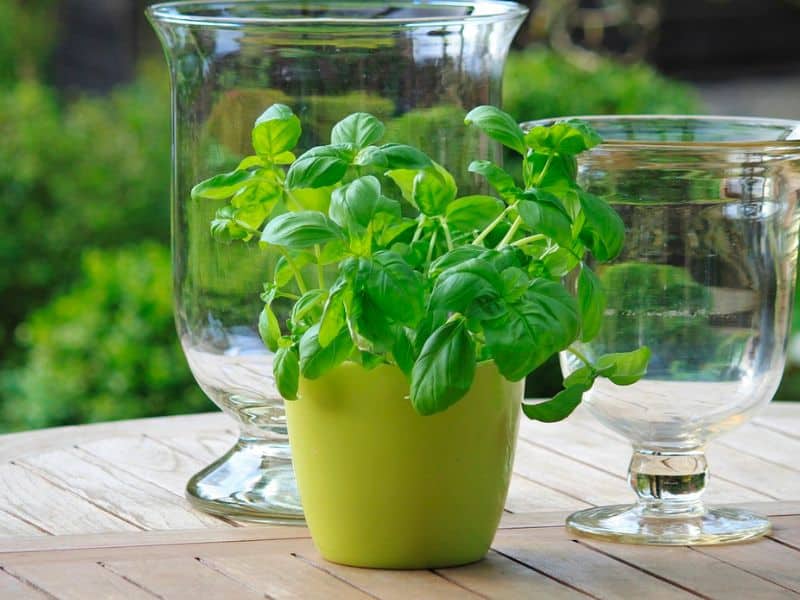
Parsley
Parsley (Petroselinum Crispum) is an herb commonly used in companion planting and is ideal for your tomato garden because it has multiple functions.
This herb attracts predatory insects like hoverflies and ladybugs that can help ward off pests like aphids and tomato hornworms. The flowers of this plant can also increase tomato yields because it lure pollinating insects like bees to your crops. Many also believe that parsley helps tomatoes grow faster and healthier.
This helpful plant is widely used as a garnish in foods and beverages, and many use it as a fragrance for soap and cosmetic products because of its rich aroma. Raw parsley is a nutrient-rich food source with many antioxidants and vitamins.
These perennial plants take about a year before they will start to bloom and produce seeds. Parsley growths can also become quite large and might need to be trimmed to keep room for tomatoes.
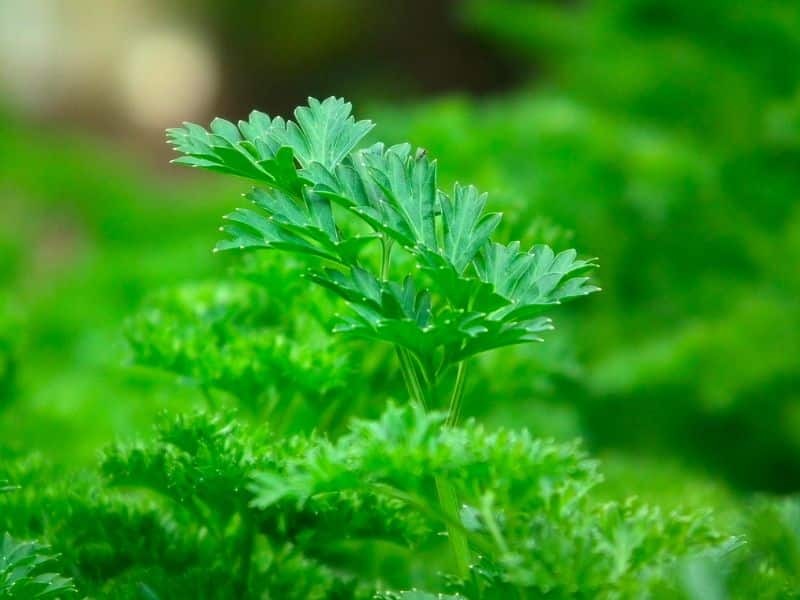
Tomato Companion Plants For Pest Control
Tomatoes are vulnerable to various pests like aphids, spider mites, flea beetles, and leafminers. Those who are keen on organic gardens should consider the following plant species to repel pests without the use of pesticides.
Thyme
Thyme (Thymus vulgaris) is an ideal companion plant to add to your garden bed because it assists in fighting armyworms (Spodoptera frugiperda), which are very common insect pests for young tomato plants. These perennials also act as living mulch around tomato plants, which helps keep moisture in the soil and reduces the temperatures around your tomato’s root system.
The herb thyme can be used in cooking and medications. In fresh form, this herb can enhance the taste of stews or be dried and used as medicine or spice.
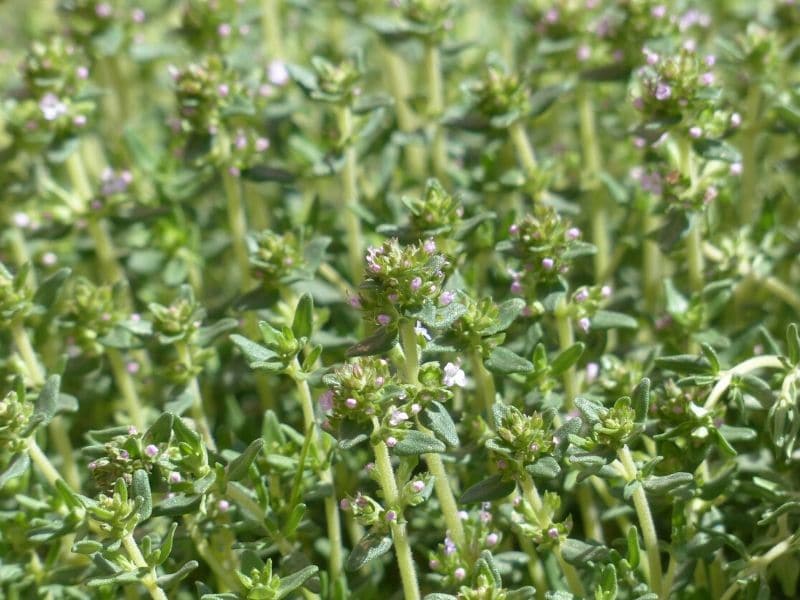
Garlic
Some consider garlic (Allium sativum) the king of companion plants. This plant is excellent for repelling spider mites. It may help keep other flying and crawling insects like aphids, caterpillars, tomato worms, cutworms, beetles, and slugs away from your tomato plants.
You can also make a spray with garlic to protect your vegetable garden and soil from blight and root-knot nematode.
For optimal results, it is recommended to plant garlic between your tomatoes. The garlic should be planted a month before tomatoes if you wish to harvest garlic and sow tomatoes simultaneously.

Asparagus
Asparagus (Asparagus Officinalis) is another good companion plant with tomatoes, but not just for the sake of your tomatoes. Tomatoes repel asparagus beetles because they produce a chemical called solanine. This helps keep asparagus beetles from feeding on the asparagus spears.
The asparagus plant protects your tomato growth because it helps eliminate root-knot nematodes that the tomatoes might attract.
For this companion planting form, however, you need to be strategic. Asparagus plants take 2 – 3 years to mature fully and will continue to produce a crop for up to 15 years.
It is best to intergrow tomatoes and asparagus by placing a line of tomatoes on both sides of your asparagus lanes. The tomatoes will be easier to harvest, and next year’s growth will also benefit from the same asparagus plantation.
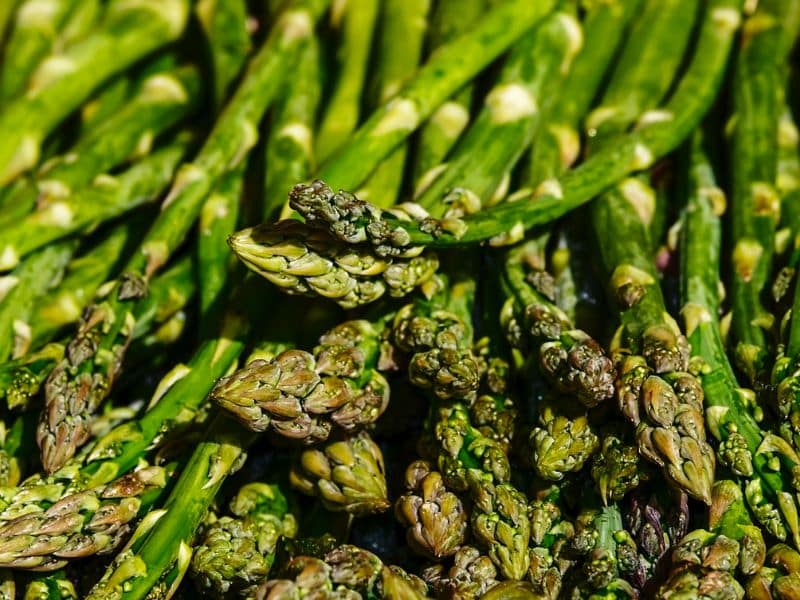
Tomato Companion Plants for Increasing Beneficial Insects
Not all insects are pests. The right type of insects are very helpful for increasing tomato yields and can certain predatory insects can help keep other pests under control. Here is a quick look at some of the best beneficial companion plants if you want to lure helpful insects to your garden.
Dill
Young dill (Anethum graveolens) is a popular plant in herb gardens and can be helpful in your vegetable garden. This plant produces tiny nectar-producing flowers that attract all sorts of beneficial insects. When your dill plants bloom, they attract ladybugs, lacewings, parasitic wasps, tachinid flies, and many other insects to your garden.
The parasitic wasps will kill off pests like tomato hornworms, fruit worms, and other caterpillars by laying their eggs inside these worms. Ladybugs mainly feed on aphids and are frequently used to combat large aphid infestations in crops. The dill will also attract some fertilizing insects that might boost the number of juicy tomatoes on your plants.
Besides attracting beneficial insects, dill is also handy around the kitchen. This herb can be used for seasoning food, making tea blends, as a beautiful garnish, or in salads.
When planting tomatoes, you should add plenty of young dill to the garden and allow it to bloom for optimal effect.
Just be careful to remove mature dill plants after they flower. Mature dill tends to have the opposite effect on tomatoes and can inhibit their growth.
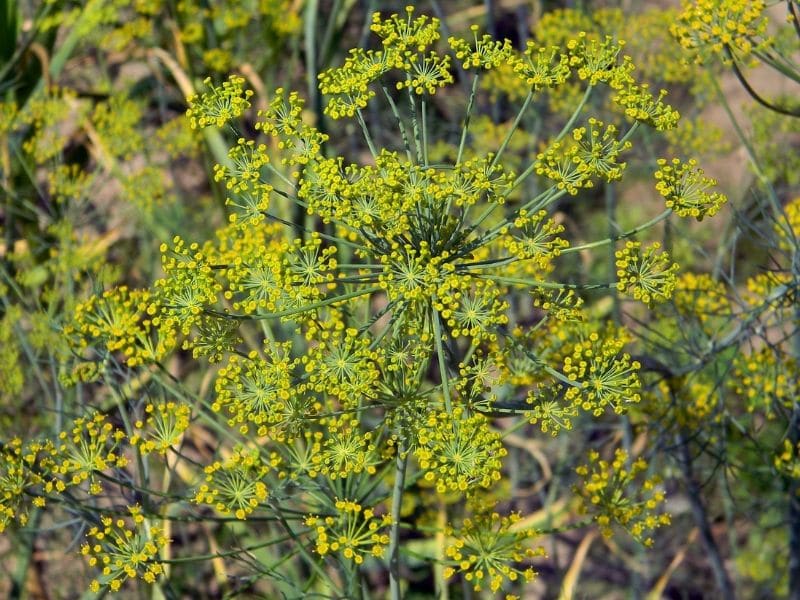
Sweet Alyssum
Sweet alyssum (Lobularia maritima) is a great companion plant to grow beneath tomato plants because their white blooms attract syrphid flies and parasitic wasps. This is an excellent solution for combating aphids and many caterpillar species that might want to feed off your tomatoes.
Adding sweet alyssum to your garden will also enable you to optimize your garden’s efficiency since this plant species only grows 3 – 9 inches tall and won’t hinder sunlight to the tomato crops.
This foliage’s leaves and edible flowers taste a lot like broccoli leaves and can be used in salads as a food spice. However, most people prefer to use this plant for medicinal purposes.
And if you don’t like the taste of this herb, then you will undoubtedly love the aesthetic appeal they offer when those white blooms flower around your tomato plants.
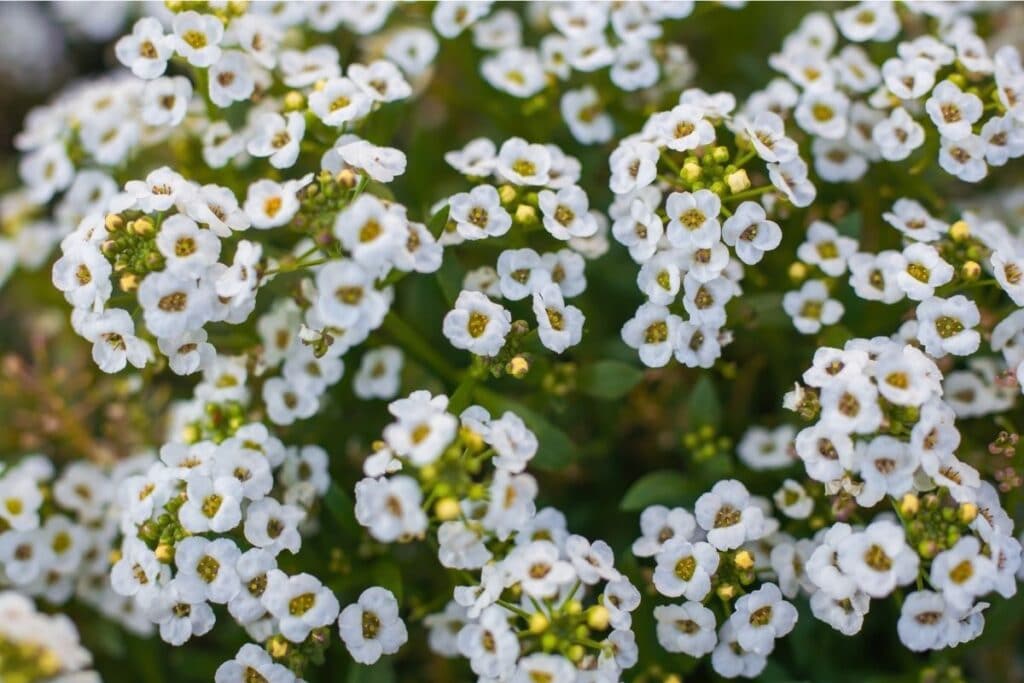
Oregano
Oregano (Origanum vulgare) is a very useful plant to include in your garden because it attracts beneficial insect species and is a delicious food source.
The oregano flowers lure a wide range of pest-eating insects to your garden. These beneficial insects will fight off pest infestations that might harm your crop. This plant also acts as a ground cover and will keep moisture trapped inside the soil, keeping your tomato plant from drying out.
Both the leaves and flowers of the oregano plant are edible. This edible plant can be used as a flavoring for bread and pizza, it is frequently used in marinades or stuffings, and fresh leaves compliment salads very well. A lot of people also use dried oregano as a meat seasoning.
You can plant oregano all around your tomatoes, but, since it is a perennial, it is best to grow it in a way that allows you to harvest and replace tomatoes throughout the seasons easily. For optimal results, allowing oregano to bloom before you start harvesting too much is best.

Tomato Companion Plants For Weed and Disease Control
Most tomato varieties are tall or vine plants that need support to keep heavy ripe tomatoes away from the ground where ants can attack them. This leaves a lot of open space around the base of the tomato plant that can become overrun with weeds.
Companion planting with other vegetable varieties is a good way to utilize this wasted space and can help control weeds and diseases underneath your tomato growth.
Let’s look at some of the best vegetable plants to grow with tomatoes to make the most of your garden bed.
Cucumbers
Cucumbers (Cucumis sativus) are crawling plants that can be used as a weed-managing tool. This is because cucumbers secrete growth, inhibiting allelochemicals like cinnamic acid that keep other vegetation, like weeds, from sprouting and suppressing weeds.
These vegetable plants form a thick ground cover and act as a mulch to keep the root system of taller plants from becoming too dried out. This thick growth also keeps sunlight from reaching the soil so weeds cannot germinate.
It is also a huge benefit to produce a tasty cucumber and tomato salad when you combine these two complementary plants in the same garden bed.
Cucumbers are best paired with vine tomato varieties like cherry tomatoes since one of these vines can take up a lot of space without using nearly as much ground area.
Related: Cucumber Companion Plants
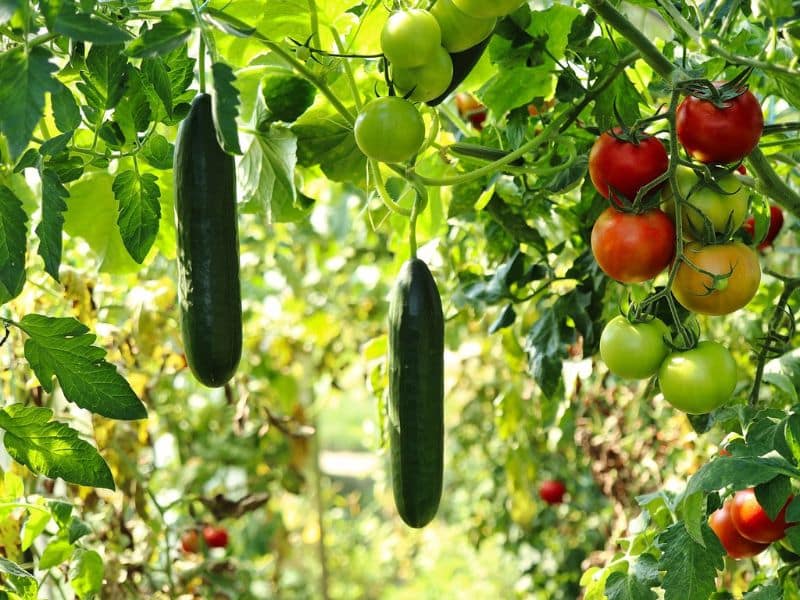
Sweet Potatoes
For various reasons, sweet potatoes (Ipomoea batatas) are a good ground cover for underneath large vine tomatoes.
The sweet potato leaves will keep tomato fruits off the ground so insects cannot reach them. This plant also eliminates the spores of fungal diseases like Septoria and early blight that live in the soil. It combats these fungal diseases by keeping the spores from splashing onto the tomato leaves when water drops hit the ground.
As a ground cover, it will keep some moisture locked inside and prevent weeds from germinating underneath your tomato growths.

Bush beans
Bush beans can also attract beneficial insects that might fertilize your tomatoes or keep pests at bay.
Bush beans (Phaseolus vulgaris) are other companion plants that can be used to maximize your garden. The bushy design of this short-statured plant does a great job of increasing air circulation around the base of your tomato plants. This can help eliminate diseases that flourish in humid conditions.
Naturally, you can plant all sorts of short vegetable plants around the base of a tall tomato variety. However, we recommend bush beans because it is a good option for increasing the yields of your vegetable garden.

Avoid Planting These Plants Around Tomatoes
Some plants do not do as well around tomatoes or might hinder the growth of your tomato patch. Let’s take a quick look at some of the plant varieties to keep far away from your tomato plants.
Cabbage
All plants of the cabbage family (Brassicaceae) should be kept far away from your tomato growths, and it is best not to grow a tomato crop where a cabbage crop used to be.
Tomatoes and cabbages are sworn enemies because cabbage plants source plenty of nutrients from the soil throughout the growing season. A cabbage growth can easily deprive your tomato plants of nutrients and hinder the growth and size of mature tomato plants.
Corn
Corn (Zea mays) is another vegetable plant that shouldn’t be grown anywhere near your edible crops. This is because corn attracts a very destructive worm, the corn earworm, and its moths to your vegetable and herb garden. These destructive species will create large tunnels in tomato fruits and can even devour the leaves and stems of your crops. This resilient pest is also tough to clear from fields and gardens. Corn can also attract other types of pests that are sure to ruin your vegetable garden.
Fennel
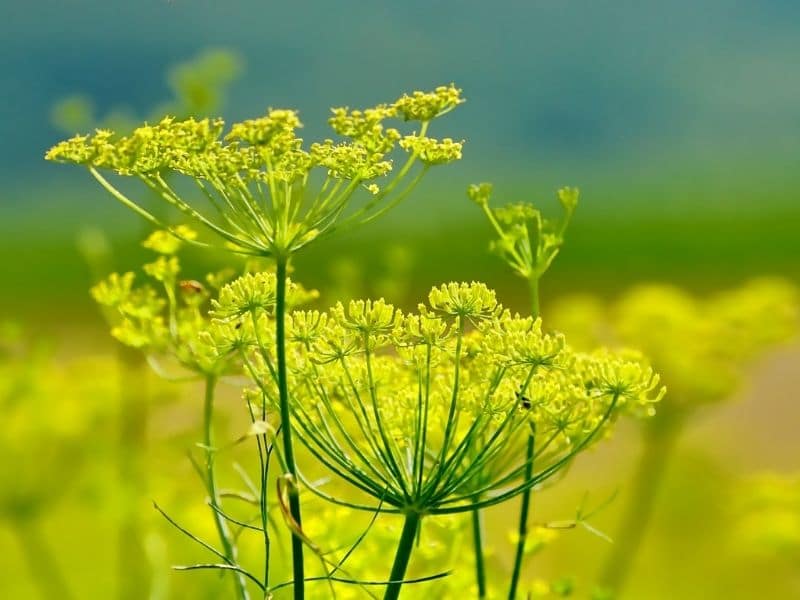
Fennel (Foeniculum Vulgare) is a herb that doesn’t pair well with any growing plants. Most gardeners recommend planting these herbs all on their own or in a garden pot. This is because fennel releases a chemical that inhibits the growth of other plants, including tomato plants.
Mature Dill
We already mentioned that you want to include young dill in your garden. But mature dill should be removed shortly after blooming and before seeding. Once the dill starts to plant, it no longer offers beneficial effects and can even begin to hinder your tomatoes’ development.
Final Thoughts
Many companion plants for tomatoes can boost the health and growth of your tomato plants. We hope this guide made it easier for you to choose an excellent companion plant to grow alongside tomatoes.
If you are looking for more advice on growing your food or ways to enhance your vegetable crops, then you should look at some of our other guides. We are constantly sharing the best advice to help your garden flourish.
Up next:

